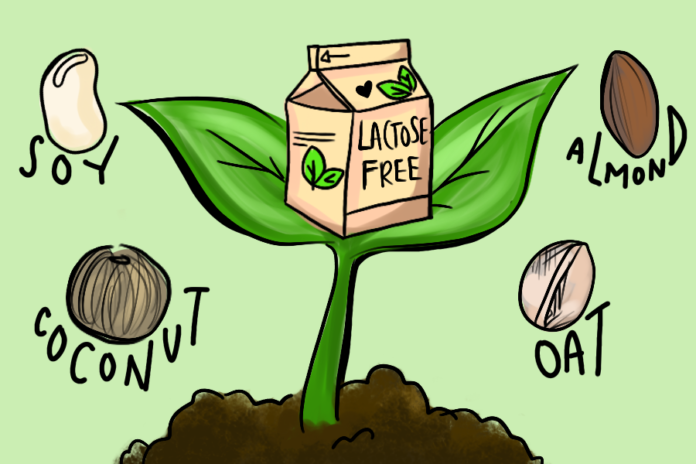Consider dropping products containing lactose
By MAYA KORNYEYEVA — mkornyeyeva@ucdavis.edu
Virtually every coffee shop and restaurant now offers dairy-free milk options for customers. You walk into any Starbucks, Peet’s or Philz — not just in downtown Davis but around the world — and you are immediately greeted with a smiling employee who proceeds to take your order while listing three or four milk alternatives.
In my experience, many businesses encourage consumers to opt for dairy substitutes, and for a good reason. These milks are easier to source, more sustainable and generally simpler to maintain than products from cows or other livestock. It is also easier to ensure their consistent quality.
Soy, oat, almond, coconut, rice, cashew, hemp, hazelnut and macadamia milk are among the most popular options that have surfaced in the past several decades, leading to a massive surge in the industry of plant-based milk production.
You might be wondering when it all started, and why lactose-free milk alternatives are suddenly all the rage. To answer this question, we must direct our attention to the early 20th century, with the emergence of soy milk as a popular ingredient in East Asia. This key player in what is now a multi-billion dollar trade had humble beginnings. Soy milk originated in a small chain of farms in China, where soy initially served as an additive in tofu and nutritional non-dairy creams.
The issue with the first iterations of soy milk (and indeed all plant-based milks) was the “vegetable” taste and short shelf life, which caused many Americans to avoid lactose-free drinks like the plague. “Why drink lactose-free milk when you don’t have to?” was a question I often heard posed in the early days of milk alternatives, when products were just hitting the shelves.
As more research was devoted to the production of lactose-free milks, the taste was significantly refined, transforming into the creamy, naturally sweet plant-based milks you can find at the supermarket today. Further into the stages of development, non-dairy milks gained a longer expiration date, lasting several weeks rather than just a few days.
In addition to their delicious taste, plant-based milk alternatives offer a wide range of benefits. First, it is undeniable that they have a more positive impact on the environment than cows’ milk. Raising and maintaining cows takes up a massive amount of land, with 41% of United States soil devoted to cow pastures (that’s 124.7 million acres!). Cows are also a large producer of methane gas, which is one of the most abundant and harmful greenhouse gasses in our atmosphere.
In contrast, plant-based milks, like soy and oat, are produced from plants that are able to photosynthesize and effectively remove carbon dioxide from the atmosphere, improving our air quality and diminishing the effects of global warming. Aside from having a minimal carbon footprint, farming plants like soy is much more water efficient, with soy milk production using less than one-third of the water necessary for dairy milk.
Few can argue against the established ecological benefits of milk alternatives, but what are the drawbacks? Believe it or not, a primary one is the cost. Oat milk specifically involves only two ingredients — oats and water — but the equipment that is necessary to drain, filter and cream the oats is expensive. This is why oat milk is almost two-and-a-half times more costly than dairy milk, averaging around $5.29 per half-gallon bottle.
The increased price tag on plant-based milks is a valid reason to be nervous about switching away from dairy; is it really worth the effort and the dip in your bank account?
I believe the answer is yes, not only because of the environmentally-friendly nature of plant-based milks, but also because of the nutritional benefits. Research suggests that coconut milk has properties that help with weight loss, body composition and metabolism. Soy milk includes essential Omega-3 fatty acids and antioxidants, as well as anti-inflammatory and cardioprotective properties. Oat milk promotes healthy blood pressure and iron levels, while almond milk is an excellent source of calcium (which is one of the healthiest minerals found in lactose products).
Making the simple switch from dairy to non-dairy milk can also expose you to a new flavor palette. We all know the taste of cows’ milk, which doesn’t vary much from gallon to gallon. However, the different varieties of plant-based milks are distinct in both texture (ranging from non-fat milk consistency to thick and creamy) and taste. Trying oat milk in your cereal, or almond milk in your lattes, can change the flavor entirely, as the different nutrients in the milk alternatives mix with the espresso or the Cheerios. The bottom line is that there is a substantial reason behind the newfound popularity of plant-based milk alternatives.
While non-dairy milks are slightly more expensive than the cows’ milk everyone is used to, choosing them over dairy means you’re not only helping the environment, but also supplying your body with healthy minerals and nutrients. The less consumers are drawn to cows’ milk, the smaller the industry will become, and the healthier our planet will be.
I challenge you to take this first step and explore the dozens of plant-based milk varieties that are out there. Perhaps you will even find your favorite milk alternative, like I have, or at least get the opportunity to experiment and try something new.
Written by: Maya Kornyeyeva— mkornyeyeva@ucdavis.edu
Disclaimer: The views and opinions expressed by individual columnists belong to the columnists alone and do not necessarily indicate the views and opinions held by The California Aggie.





